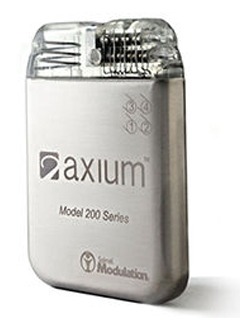
At the International Neuromodulation Society’s 12th World Congress (INS; 6–11 June, Montreal, Canada) principal investigator, Timothy Deer, presented the three-month data (ie. the FDA defined primary endpoint for safety and efficacy) of the ACCURATE trial for the first time. He reported that dorsal root ganglion (DRG) stimulation showed not only non-inferiority, but also superiority over conventional spinal cord stimulation across all primary endpoint analyses.
Although dorsal root ganglion stimulation is approved and has been in use in Europe and Australia for some time, in the United States, DRG stimulation remains under investigation. The US-based ACCURATE study is the first largescale, prospective randomised clinical trial of dorsal root ganglion stimulation versus conventional spinal cord stimulation for patients with complex regional pain syndrome and peripheral causalgia.
Giving some background into the premise of dorsal root ganglion stimulation, Robert Levy (Marcus Neuroscience Institute at Boca Raton Regional Hospital, Boca Raton, USA) explained that the dorsal root ganglion is a simple spinal structure that is bounded by the dura and it is where the cell bodies of the peripheral nociceptors live. He said, “As an intradural structure it is in the neuroaxis, and for neurostimulation purposes, it is important to recognise that unlike the dorsal columns where there is a large layer of cerebrospinal fluid between the epidural space where we put our lead and where our current is targeted and we lose 80–90% of our current in the low-resistant cerebrospinal fluid pathways and only 10–20% of our current gets to the target fibres where we are trying to stimulate, here there is minimal cerebrospinal fluid and an epidural lead laying over the dorsal ganglion is very efficient, using about 5% of the total energy we use for dorsal column stimulation. It is a target that has been used for a number of different interventions and it is accessible via an intraspinal approach.”
The primary objective of the ACCURATE study is to assess the safety and efficacy of dorsal root ganglion stimulation (delivered by the Axium device from Spinal Modulation, recently acquired by St Jude Medical) compared to a commercially available spinal cord stimulation device. The multicentre, prospective, randomised trial was designed with significant input from the US Food and Drug Administration (FDA). It was a non-inferiority study design, but it had power with a sufficiently robust effect, to demonstrate superiority as well. Importantly, once patients were randomised to one or another therapy arms, the people who were responsible for that therapy were the representatives from that company.
Therefore, if patients were randomised to the spinal cord stimulation arm, the devices were maintained, programmed and optimised by representatives from that company, and similarly, patients randomised to DRG therapy were maintained by Spinal Modulation, providing for an equal bias to optimise the stimulation and prove best effect.
There were 152 subjects enrolled, randomised 1:1 between DRG and dorsal column traditional stimulation at 22 sites with a three-month primary endpoint. Included were patients with chronic intractable pain in their legs and who carried a diagnosis of complex regional pain syndrome or peripheral causalgia.
The primary endpoint was a composite endpoint where all patients had to have a greater than 50% pain relief at the trial, greater than 50% pain relief at the time of their three-month follow-up and be free of any stimulation-induced neurological deficits. If they met all three of those criteria, they were considered successful. Secondary endpoints included an evaluation of both paraesthetic intensity and the positional effects on paraesthetic intensity between spinal cord and dorsal root ganglion stimulation. The tertiary endpoints were the specificity of stimulation—that is the overlap of paraesthesias and the patient’s pain, quality-of-life, psychological disposition, functional status and patient satisfaction.
During the presentation at INS, it was reported that in the modified intent to treat group (made up of the 152 patients randomised) 55.7% of patients treated with conventional spinal cord stimulation met the primary endpoint of 50% or more pain relief, while in the DRG group, 81.2% of patients had relief. Superiority of dorsal root ganglion stimulation as compared to conventional spinal cord stimulation was shown, with a superiority p value of 0.0004.
Further, in the primary endpoint sub-analysis (those who went to permanent implant and then met the three-month endpoint) 72.2% of patients in the conventional group met the primary endpoint at three months post-implant, while in the dorsal root ganglion group, 93.3% of patients met the primary endpoint—indicating non-inferiority and superiority (p=0.0011) of DRG stimulation.
In terms of high responders, 52% of patients in the conventional group versus 70% of patients in the DRG group saw 80% or more improvement (p=0.055). Additionally, in terms of secondary endpoints, patients receiving DRG stimulation reported no differences in paraesthesia intensity due to changes in body position (postural effects) when compared to conventional spinal cord stimulation. A statistically significant result was found between the two groups studied. Also, patients in the DRG stimulation group were significantly less likely to report feeling stimulation outside their area of pain, compared to the control group. As it relates to safety, there was no reported deficit in either group.
Overall, at three months, the ACCURATE study demonstrated that the DRG group was statistically non-inferior and then superior in the composite endpoint of safety and efficacy as compared to the spinal cord stimulation control group. The DRG group demonstrated a comparable safety profile to the commercially available technology that was used as a comparator, DRG showed a greater percentage of patients that responded to therapy overall, produced less positional effects comparing stimulation groups, and also had more specific paraesthesia as compared to conventional stimulation.
According to clinicaltrials.gov, the ACCURATE study’s estimated final data collection date for primary outcome measure is December 2015 and the estimated study completion date is December 2018.












